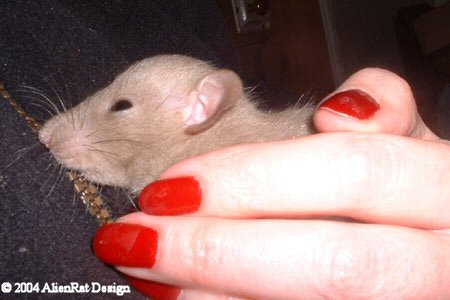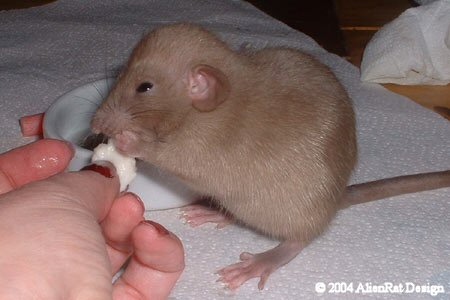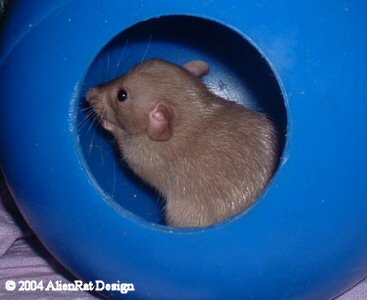Figure 3: Hydrocephaly in 4-month-old rat
Case history and photos
History
Male rat (now 4 months old) was failing to thrive and his head was clearly domed. He
had motor coordination problems and did not interact with his littermates. It was later learned that the mother of this rat had uterine infection positive for the organism pasteurella, which may or may not have contributed to the condition. No other littermates were known to have developed hydrocephaly.
Clinical Signs
What is most obvious is the domed head. He also sways and pulls his head up and backward. Has tendency to bite and chew everything, but doesn’t bite very hard. Spatial awareness problems. Lack of dexterity, cannot hold small things with hands, doesn’t know how to use water bottle. Lactose intolerance.
Diagnosis
Hydrocephaly
Treatment
At this time he is quite strong and healthy so no treatment is required so far. One vet tried the homeopathic treatment Apis Mel 30C given once a day in his food but it made no difference at all. He is housed in a large hamster cage on his own with two low shelves. If he develops seizures, shelves will be removed. He is fed mostly
meat/vegetable type baby food (lactose free, occasionally complemented with Enervite), homemade pureed foods, soy milk and dog biscuits which he is able to manage as they are bigger than rat food biscuits. He
gets all the moisture he needs from the soft foods.
Outcome
So far he is living a happy and relatively healthy life, and his growth is slow but steady. He is thriving better on his own where he doesn’t have to compete for food.
Photos
 Photo 1: Shows profile view of dome shaped head in rat with hydrocephaly . |
 Photo 2: Shows assistance given during feeding of a rat with hydrocephaly. |
 Photo 3:Shows close up view of the dome shape head in rat with hydrodcephaly . |
 Photo 4: Shows again a profile view of the dome shaped head . |
Case history and photos courtesy of Sabby at http://www.alienrat.co.uk/pe.html


